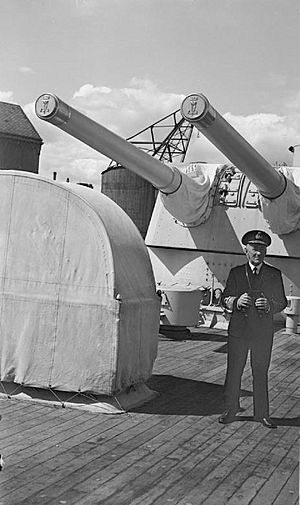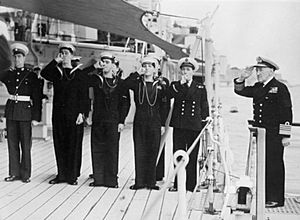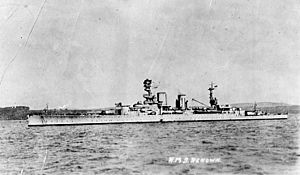Rhoderick McGrigor facts for kids
Quick facts for kids
Sir Rhoderick McGrigor
|
|
|---|---|

Vice Admiral McGrigor on the deck of his flagship HMS Norfolk, June 1945
|
|
| Born | 12 April 1893 York, England |
| Died | 3 December 1959 (aged 66) Tarland, Scotland |
| Allegiance | United Kingdom |
| Service/ |
Royal Navy |
| Years of service | 1910–1955 |
| Rank | Admiral of the Fleet |
| Commands held | First Sea Lord Plymouth Command Commander-in-Chief Home Fleet 1st Cruiser Squadron Home Fleet aircraft carriers Flag Officer, Taranto and Adriatic Flag Officer, Sicily Force B at Pantellaria and Sicily 4th Destroyer Flotilla HMS Versatile |
| Battles/wars | First World War |
| Awards | Knight Grand Cross of the Order of the Bath Mentioned in Despatches Commander of the Royal Norwegian Order of St Olav |
Admiral of the Fleet Sir Rhoderick Robert McGrigor (born 12 April 1893 – died 3 December 1959) was a very important officer in the Royal Navy. He fought in both the First World War and the Second World War. He took part in major events like the Gallipoli Campaign and the Battle of Jutland. During World War II, he helped sink the German battleship Bismarck. He also led naval forces in the Arctic convoys and off the coast of Norway. Later, he became the First Sea Lord, the highest-ranking officer in the Royal Navy. He is best known for strongly supporting the use of aircraft carriers in naval warfare.
Contents
Early Life and Training
Rhoderick McGrigor was born in York, England. His father was a high-ranking army officer. Rhoderick spent his early childhood in South Africa. In 1906, he returned to England for his education. He studied at the Royal Naval College, Osborne, and then the Royal Naval College, Dartmouth. These were special schools for future naval officers.
He became a midshipman in 1910. This was his first officer rank. He served on battleships like HMS Formidable and HMS Africa. By 1913, he was a sub-lieutenant. He then joined the destroyer HMS Foxhound.
Service in World War I
During the First World War, McGrigor was promoted to lieutenant in 1914. He took part in the Gallipoli Campaign in 1915. This was a difficult battle in Turkey. Later, he joined the battleship HMS Malaya. On this ship, he fought in the Battle of Jutland. This was a huge naval battle between Britain and Germany.
After the war, he continued to rise through the ranks. He became a lieutenant commander in 1922. He also studied at the Royal Naval Staff College. He became an expert in torpedoes, which are underwater weapons. In 1927, he was promoted to commander. He then worked on the staff of the Home Fleet. This was a major part of the British Navy. In 1932, he commanded the destroyer HMS Versatile. He became a captain in 1933. By 1938, he was a commodore. He served as Chief of Staff for the China Station. This was a British naval base in Hong Kong.
World War II Actions
When the Second World War began, McGrigor played a key role. In early 1941, he was on the battlecruiser HMS Renown. This ship was involved in protecting convoys to Malta. These convoys carried vital supplies. He also took part in the attack on Genoa in Italy.
One of his most famous actions was helping to sink the German battleship Bismarck. This happened in May 1941. The Bismarck was a very powerful enemy ship. McGrigor was promoted to rear admiral in July 1941. He then worked as Assistant Chief of the Naval Staff (Weapons). This meant he helped develop and manage naval weapons.
In 1943, he led naval forces during the capture of Pantelleria. This was an Italian island. He also helped with the Allied invasion of Sicily. For his bravery, he received the Distinguished Service Order. He was wounded while serving in Sicily. After recovering, he commanded naval forces in the Taranto and Adriatic regions.
In 1944, McGrigor commanded aircraft carriers in the Home Fleet. He then led the 1st Cruiser Squadron. His flagship was HMS Norfolk. He took part in operations off the coast of Norway. He also helped protect the convoys going to North Russia. These convoys delivered important supplies to the Soviet Union. He was recognized for destroying enemy ships off Norway in November 1944.
He became a vice admiral in April 1945. He was also Second-in-Command of the Home Fleet. He led the last air-raid of the war in Europe in May 1945. After the war, he helped bring King Haakon back to Norway. King Haakon had been in Britain during the war. For this, McGrigor received a special award from Norway.
Post-War Leadership

After the war, McGrigor held many important positions. In 1945, he became the Vice Chief of the Naval Staff. This was a very senior role. He was promoted to full admiral in 1948. In 1949, he became the Commander-in-Chief, Home Fleet. This meant he was in charge of a large part of the British Navy.
He also led a major naval exercise called Exercise Verity in 1949. This exercise involved several European navies. In 1950, he became Commander-in-Chief, Plymouth. This was another important command. He received the highest honor, Knight Grand Cross of the Order of the Bath, in 1951.
On 20 December 1951, McGrigor became the First Sea Lord. This is the professional head of the Royal Navy. He served during the funeral of King George VI and the coronation of Queen Elizabeth II. As First Sea Lord, he strongly believed in the power of aircraft carriers. He brought back the name "Fleet Air Arm" for the navy's aircraft branch. He was promoted to Admiral of the Fleet in 1953. This is the highest rank in the Royal Navy. He retired from service in April 1955.
After retiring, McGrigor received honorary degrees from two universities. He also served as Rector of the University of Aberdeen. He enjoyed shooting and fishing at his home in Scotland. Sir Rhoderick McGrigor passed away on 3 December 1959.
Images for kids





